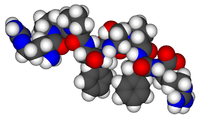
Photo from wikipedia
Mast cells (MCs) have relevant participation in inflammatory and vascular hyperpermeability events, responsible for the action of the kallikrein–kinin system (KKS), that affect patients inflicted by the severe form of… Click to show full abstract
Mast cells (MCs) have relevant participation in inflammatory and vascular hyperpermeability events, responsible for the action of the kallikrein–kinin system (KKS), that affect patients inflicted by the severe form of COVID-19. Given a higher number of activated MCs present in COVID-19 patients and their association with vascular hyperpermeability events, we investigated the factors that lead to the activation and degranulation of these cells and their harmful effects on the alveolar septum environment provided by the action of its mediators. Therefore, the pyroptotic processes throughout caspase-1 (CASP-1) and alarmin interleukin-33 (IL-33) secretion were investigated, along with the immunoexpression of angiotensin-converting enzyme 2 (ACE2), bradykinin receptor B1 (B1R) and bradykinin receptor B2 (B2R) on post-mortem lung samples from 24 patients affected by COVID-19. The results were compared to 10 patients affected by H1N1pdm09 and 11 control patients. As a result of the inflammatory processes induced by SARS-CoV-2, the activation by immunoglobulin E (IgE) and degranulation of tryptase, as well as Toluidine Blue metachromatic (TB)-stained MCs of the interstitial and perivascular regions of the same groups were also counted. An increased immunoexpression of the tissue biomarkers CASP-1, IL-33, ACE2, B1R and B2R was observed in the alveolar septum of the COVID-19 patients, associated with a higher density of IgE+ MCs, tryptase+ MCs and TB-stained MCs, in addition to the presence of intra-alveolar edema. These findings suggest the direct correlation of MCs with vascular hyperpermeability, edema and diffuse alveolar damage (DAD) events that affect patients with a severe form of this disease. The role of KKS activation in events involving the exacerbated increase in vascular permeability and its direct link with the conditions that precede intra-alveolar edema, and the consequent DAD, is evidenced. Therapy with drugs that inhibit the activation/degranulation of MCs can prevent the worsening of the prognosis and provide a better outcome for the patient.
Journal Title: International Journal of Molecular Sciences
Year Published: 2022
Link to full text (if available)
Share on Social Media: Sign Up to like & get
recommendations!